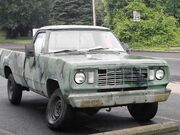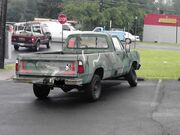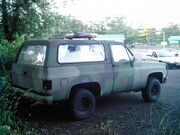The Commercial Utility Cargo Vehicle or CUCV Program was instituted to provide the United States military with a cheaper Light Utility Vehicle to augment the purpose-built, but expensive, Gama Goats and Humvees then coming into service. It initially provided Dodge D Series and then Chevrolet C/Ks with several military modifications. All were phased out sooner than expected due to their inability to survive the hardships that the purpose built vehicles could endure. The vehicle has five basic configurations; cargo, utility, ambulance, shelter carrier, and chassis. The vehicles were purchased in the late 1970s and early 1980s from Chrysler Corporation, Dodge Division, and in the mid 1980s from General Motors.
Dodge CUCVs[]

Dodge M880 right front

Dodge M880 rear
The CUCVs had 12 volt electrical systems and were powered with the 318 cubic inch gasoline engine. The CUCVs were an attempt by the U.S. military to use commercial off-the-shelf (COTS) vehicles with minor modifications in non-combat roles. They were intended to replace the M37 Cargo Trucks and the M715 Cargo Trucks and related variants.
Around 1973, Dodge began developing the M880 series trucks, which were militarized adaptations of their current model 4x4s. These trucks weren't known as CUCVs at the time, but were in use for many years. They had several failings: a gasoline powerplant, 12-volt electrical systems.( 24 volt kit was available) and no power steering. The electrical system was addressed by upgrades where needed, but the gasoline engine proved a fatal flaw as the military moved increasingly to diesel engines. The lack of power steering in the military vehicles was a great hindrance in off road and close quarters work (although many civilian and air force models had power steering). Around 44,000 M880s were produced during the 1976 and 1977 model years, and served for the Army and Air Force until the early 1990s.
An armored variant was built by Cadillac Gage as the Ranger.
Specs[]
- Chrysler 318 cubic inch engine (5.2 liters)
- 2 bbl Carter or Holley Carburetor
- 150 H.P.
- 230 TQ
- Torqueflite 727 automatic transmission
- 2-speed New Process transfer case, NP203 (full-time 4x4)
- Leaf springs all around
- Dana 44 solid front axle (4.10:1 axle gearing)
- Dana 60 solid rear axle (full-floating, 4.10:1 axle gearing)
- Front Disc brakes
- Rear drum brakes
- Manual Steering
- 70 MPH top speed
- 10 on road and 8 off road MPG.
Four-wheel drive[]
- M880 - Basic Dodge 4x4 pickup truck model.
- M881 - M880 fitted with additional 60-amp 24-volt generator.
- M882 - M881 fitted with communications equipment.
- M883 - M881 fitted with slide-in shelter kit.
- M884 - M880 fitted with 100-amp 24-volt generator and slide-in shelter kit with tie-downs.
- M885 - M880 fitted with slide-in shelter kit with tie-downs.
- M886 - Ambulance model based on M880.
- M887 - Maintenance body based on M880.
- M888 - Telephone maintenance body based on M880.
Two-wheel drive[]
- M890 - 4x2-wheel drive version of the M880.
- M891 - M890 fitted with additional 60-amp 24-volt generator.
- M892 - M890 fitted with additional 60-amp 24-volt generator and communications kit.
- M893 - 2-wheel drive ambulance version.
General Motors[]

A Lithuanian Army M1008 CUCV Pickup
The GM CUCVs were produced in the 1984-86 time period (mostly 1984) and were powered by 6.2L Detroit Diesel V8 engine. The GM CUCVs were assembled mostly from the heaviest duty bits and pieces from the light commercial truck lines. The CUCVs came in three basic body styles, a pickup, a utility and an ambulance body. A chassis cab fitted with a service body could be called a fourth. The M1008 was the basic cargo truck, the M1010 was the ambulance and the M1009 3/4 ton utility rig, which was a stripped Blazer uprated to 3/4-ton capacity. With the exception of the M1009, the trucks were all rated as 1-1/4 ton (commonly called a “five-quarter”), even though some of them had payloads in excess of that. In the truck lines there were some heavy duty variants, to include the M1028, M1028A1, M1028A2 and M1028A3 shelter carriers, the shelter being a mobile command or communications enclosure. The M1031 was the chassis cab which was most commonly found in the two door version. These latter trucks were all rated for heavier 3,600 or 3,900 pound loads, vs. the M1008s 2,900 pound load capacity. The M1028A2 and A3 models had dual rear wheels.
Powertrain[]
All the CUCVs were powered by GM’s 6.2L J-series Detroit Diesel V8 engine non-emissions diesel. These were rated at 155 hp (116 kW) and 240 lb·ft (325 N·m), which was 5 hp (3.7 kW) more than the emissions diesel engine of the time. They were all equipped with the TH-400 automatic. All but the M1028A1 and M1031 used the NP-208 chain drive transfer case. The M1028A1 and M1031 units had a slip-yoke rear output version of the NP-205, which was specified mainly for its PTO capacity.
Axles[]
The M1009 Blazer used 10-bolt axles (front and rear) featuring 3.08:1 gears. The rear axle was equipped with an Eaton Locker (“Gov-Lok”) with the front being a standard open differential. The M1008 trucks used open Dana 60 front axles, with the M1028 and M1031 variations often having a Trac-Lok limited slip. In the rear, the M1008s used the GM 10.5-inch (270 mm) 10.5" Corporate 14 Bolt Differential with No-Spin lockers (the commercial trade name for the Detroit Locker). Though the M1028A2 and A3 duallies have Dana 70 HD axles. Axle gear ratios were 4.56:1.
Electrical[]
As with other military vehicles, the CUCVs used a 24-volt electrical system. It was actually a hybrid 12/24-volt system that used 24-volts under the hood, complete with dual 100 amp alternators, the mandatory NATO slave receptacle for jump starting any NATO vehicle, and hookups for military radios. The rest of the truck was 12-volt.
GM Defense[]
GM produced some 70,000 from 1983 to 1986 most for the military. For the past several years, GM Defense has been working over the newest GM trucks as CUCV-II and CUCV-III units for a new generation. The older Dodge M880s were used on the battlefield in some of the brush wars of the early 1980s and the results were reported to be “disastrous.” Likewise, the GM CUCVs saw combat time in Desert Storm and as one unit commander said, the results were “less than desirable.” As a result most CUCV's were replaced by the same HMMWV's they were to augment.
The GM CUCV may not have made the grade as a battlefield vehicle, but it served well enough in its original role as a dollar-saving bridge between out-and-out tactical vehicles and off-the-shelf civilian vehicles. Like the rear echelon human troops, they provide support for the frontline forces. CUCVs of all generations, are still in US service, though there are also many that have passed through military surplus sales into civilian ownership. In US military service, CUCVs have been removed from MTOE-based organizations in the Army and Marines, but are still in use as base / garrison support vehicles for organizations like Range Control, Base Facilities and Engineering, and other TDA[?] uses.
Variants[]
- M1008 - Basic General Motors Model K30903. The M1008 was the most numerous of the CUCV truck types. It was often seen with troop seats for eight in the bed. Some of the unique accoutrements to a CUCV are the military brush bars and tow hooks front and rear, as well as a pintle hitch. These trucks are rated to tow 3,000 pound cross country and were often used to tow the M101 3/4 ton trailer.
- M1008A1 - M1008 fitted with additional 100-amp 24-volt generator and communications kit.

Right Front view M1009 CUCV

Right View M1009 CUCV
- M1009 - Utility version of the General Motors Chevy K5 Blazer 2nd edition. The M1009 is a utility rig built from a Blazer and could be used for command and control, as well as simple hack-around duties. It was often seen with radio sets installed, however the large square tube stock mounts prevented the rear seat from being lowered. The M1009 was rated for a 1,200 pound payload and a 3,000 pound towed load. It used the heaviest duty GM springs available for the chassis and the rear axle was a 10-bolt unit. It rolled on 10.00-15 tires, had 3.08 gears and a rear Gov-Lok.
- M1010 - Ambulance version of the General Motors Model K30903.
- M1010 [USMC Command] - USMC command post vehicle.
- M1010 [USMC Ordnance] - USMC ordnance repair truck.
- M1028 - Shelter carrier version of the General Motors Model K30903.
- M1028FF - Fire fighting version of the General Motors Model K30903.
- M1028A1 - Shelter Carrier w/ PTO version of the General Motors Model K30903.
- M1031 - Chassis of the General Motors Model K30903. (contact truck)
CUCV Specifications[]
Model: '83-'86 GM M1008 CUCV
- Engine: 379ci (6.2L) Detroit Diesel V8 engine
- Power: 155 hp (116 kW) @ 3600 rpm
- Torque: 257 lb·ft (348 N·m) @ 2000 rpm
- Compression Ratio: 21:1
- Transmission: THM400, 3-speed automatic
- Transfer Case: NP-208 (unsynchronized)
- NP-205 Used in trucks requiring PTO
- Front Axle: Dana 60
- Most were open except M1028's which feature Spicer Trak-lock (limited slip)
- Rear Axle: 10.5" Corporate 14 Bolt Differential, with a Detroit Locker
- Dana 70 used in trucks with dual rear wheel modification.
- Axle Ratio: 4.56:1
- Wheelbase: 131.5 inches
- GVW: 8,800 pounds
- Curb: Weight: 5,900 pounds
- Tires: 235/85R-16E
- Fuel Capacity: 20 gallons
- Fording Depth: 20 inches
- Approach/Angle: 42 degrees
- Top Speed: 55 mph (military rating)
CUCV II[]
Chevrolet had been building a few CUCV's since the 1986 model year, mainly in low numbers to accommodate military markets that need replacements or other units that need this style of vehicle. In 1996 Chevrolet decided to start building a new generation of a CUCV to try and regain their marketplace in this niche. Mostly the US Air Force was occasionally buying small batches of these units and then GM dubbed them as the CUCV II generation. These were produced through 2001 and were civilian units sent to another plant for "militarization" on special order. They are basic 3500 SRW trucks that were originally built as white in color with gray vinyl interiors. After the usual 383 green CARC paint jobs, the bumpers and grill were the next to get customized with pintle and towing/loading shackles, extra leaf springs installed to give them a 5/4 ton rating and a host of other small changes. All CUCV's have a 24volt dual battery starting system, The rest of the truck is 12 volt with resistors on the firewall to bring it down to 12 volts. All heavy duty items are used and they are very similar to the early CUCV's.
CUCV III[]
In 2002, GM introduced the CUCV III with the new body shell. Both the II and III come with AM-FM stereo and Air Conditioning. They also come with available options such as: Brushguard, Air Compressor, On Board Navigation System, 120 VAC Inverter, front or rear winch and runflat tires.
Light Service Support Vehicle[]
Light Service Support Vehicle (LSSV) (Formerly Commercial Utility Cargo Vehicle - CUCV II AND III) and is known in Canadian service as the Light Utility Vehicle Wheeled (LUVW), 4x4, MIL COTS. The LSSV is a GM-built Silverado 2500 HD and is powered by a Duramax 6.6 liter turbo diesel engine. The LSSV is available in a crew cab or standard cab. It can also be equipped with the Enhanced Mobility Package which adds underbody protection, a tire pressure monitoring system, and other upgrades. All LSSV's are produced by AM General, a unit of MacAndrews and Forbes Holdings.
Operators[]
|
|
This section requires expansion. |
Egypt
Estonia
Ecuador [1]
Israel
Lebanon
Lithuania
Philippines
United States of America
{{{name}}} Canadian Forces 1970s-1980s
See also[]
- Desert Patrol Vehicle
- EQ2050 and SFQ 2040 , Chinese copies of the HMMWV
- Hummer/HMMWV
- Lamborghini Cheetah/Lamborghini LM002
- FMC XR311
- Land Rover Wolf
- Logistics Vehicle System
- Medium Tactical Vehicle Replacement
- Mercedes-Benz G-Class
- Peugeot P4 The French version of the MB G-Wagen
- List of "M" series military vehicles
- Renault Sherpa 2
- Sandstorm, an HMMWV modified into an autonomous vehicle
- ULTRA AP
- FN Herstal AS 24
- Technical
- Jeep/M151 MUTT
- ACMAT
- Milcot
References[]
| This page uses some content from Wikipedia. The original article was at CUCV. The list of authors can be seen in the page history. As with Tractor & Construction Plant Wiki, the text of Wikipedia is available under the Creative Commons by Attribution License and/or GNU Free Documentation License. Please check page history for when the original article was copied to Wikia |